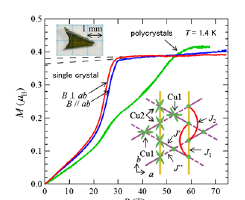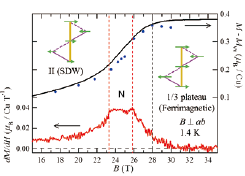One-Third Magnetization Plateau with a Preceding Novel Phase in Volborthite
Hiroi, Kindo, Tokunaga and Takigawa Groups
We have synthesized high-quality single crystals of volborthite, a seemingly distorted kagome antiferromagnet, and carried out high-field magnetization measurements up to 74 T and 51V NMR measurements up to 30 T. An extremely wide 1/3 magnetization plateau appears above 28 T and continues over 74 T at 1.4 K, which has not been observed in previous studies using polycrystalline samples (Fig. 1). NMR spectra reveal an incommensurate order (most likely a spin-density wave order) below 22 T and a simple spin structure in the plateau phase. Moreover, a novel intermediate phase called 'N' phase is found between 23 and 26 T, where the magnetization varies linearly with magnetic field and the NMR spectra indicate an inhomogeneous distribution of the internal magnetic field (Fig. 2). This sequence of phases in volborthite bears a striking similarity to those of frustrated spin chains with a ferromagnetic nearest-neighbor coupling J1 competing with an antiferromagnetic next-nearest-neighbor coupling J2. This analogy suggests that the N phase is related to a spin nematic order that is expected to appear in "frustrated" ferromagnets.

Fig. 1. Magnetization curves of volborthite measured at 1.4 K on two piles of single crystals in magnetic fields perpendicular (red line) and parallel (blue line) to the ab plane, and on a polycrystalline sample (green line). Shown also are a typical single crystal of volborthite (upper left) and the arrangement of Cu dx2−y2 orbitals projected onto the ab plane in the low-temperature P21/a structure (lower right). J1 and J2 represent the NN and NNN interactions in the Cu2 spin chains, respectively. J' and J" represent the NN interactions between Cu1 and Cu2 spins.

Fig. 2. Magnetization curve of single crystals (top, black line) and its field derivative (bottom) in B ⊥ ab at 1.4 K after the subtraction of the Van Vleck paramagnetic magnetization (MVV). Magnetization deduced from the center of the gravity of the NMR spectra is also plotted (top, blue circles). Phase 'N' with a linear field dependence of magnetization exists between phase II (SDW) and the 1/3 plateau state.
How do we understand the appearance of this series of magnetic phases in volborthite under magnetic fields? Among the various possible spin models for volborthite, we now consider a J1 − J2 − J' − J" model on the distorted kagome net (see Fig. 1) as the most likely. Using DFT + U calculations, Janson and his coworkers evaluated the magnetic interactions and found that J" is the strongest antiferromagnetic coupling, which results in a coupled trimer model [2]. In this model, the 1/3 plateau phase pertains to polarized magnetic trimers formed by J" bonds. Their theoretical considerations also predict the presence of a spin nematic phase just before the 1/3 saturation, which seems to correspond to our N phase.
References
- [1] H. Ishikawa, M. Yoshida, K. Nawa, M. Jeong, S. Krämer, M. Horvatić, C. Berthier, M. Takigawa, M. Akaki, A. Miyake, M. Tokunaga, K. Kindo, J. Yamaura, Y. Okamoto, and Z. Hiroi, Phys. Rev. Lett. 114, 227202 (2015).
- [2] O. Janson, S. Furukawa, T. Momoi, P. Sindzingre, J. Richter, and K. Held, arXiv:1509.07333.
